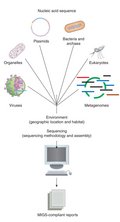Page path:
- Press Office
- Press releases 2008
- Genomic Standards for the Future
Genomic Standards for the Future
Genomic Standards for the Future: Setting the Guidelines
The pace of genomic sequencing has increased dramatically in the last years due to new sequencing techniques. At present, more than 1000 complete genomes of single cell organisms (Bacteria and Archaea) and 100 Eukaryotes (plants, animals, algae) are available in public genome databases like EMBL and GenBank. Now, an international consortium of scientists has published a new set of rules describing the minimum information and quality criteria for any genomic dataset in the international scientific journal Nature Biotechnology. The new guideline of the Genomics Standard Consortium (GSC) is called „Minimum Information about a Genome Sequence“ (MIGS) and is accessible at http://gensc.org/
The pace of genomic sequencing has increased dramatically in the last years due to new sequencing techniques. At present, more than 1000 complete genomes of single cell organisms (Bacteria and Archaea) and 100 Eukaryotes (plants, animals, algae) are available in public genome databases like EMBL and GenBank. Now, an international consortium of scientists has published a new set of rules describing the minimum information and quality criteria for any genomic dataset in the international scientific journal Nature Biotechnology. The new guideline of the Genomics Standard Consortium (GSC) is called „Minimum Information about a Genome Sequence“ (MIGS) and is accessible at http://gensc.org/
Using the new MIGS standard genomic and environmental data fields can be attributed to the different organisms (Source and copyright Nature Biotech)
Two scientists from the Max Planck Institute for Marine Microbiology in Bremen are in the GSC team which consists of nearly all big database providers and sequencing centers. Prof. Dr. Frank Oliver Glöckner is hopeful: „ We have worked now for more than seven years in the field of marine environmental (meta) genomics. The MIGS specifications and standards will be a major step forward in discovering the secrets hidden in the genes of our environmental microorganisms“.
The GSC team has put a lot of effort in the development of these new rules, as any new standard will only be accepted by the community, if it can be easily used and facilitates the exchange of data within the community. Like the introduction of the Web internet standards a couple of years ago, the MIGS standard is intended to improve the flow of data in the life sciences.
The major goal of GSC and the institutions running the public genomic databases (e.g. GenBank and EMBL) was to standardize genome information in a way that they are compatible to present and future applications. These requirements are met: anybody with an internet access can scan the genomic data sets on http://gensc.org/. Additional information about the organisms, e.g. description of their habitat or origin, will be stored in MIGS format from now on. At present, these vital information can be retrieved only by manually screening the scientific literature.
Manfred Schlösser
Contact
Prof. Dr. Frank Oliver Glöckner +49 (0)421 2028970 , [Bitte aktivieren Sie Javascript]
Renzo Kottmann, MSc +49 (0)421 2028974 , [Bitte aktivieren Sie Javascript]
Press officer
Dr. Manfred Schlösser +49 (0)421 2028704, [Bitte aktivieren Sie Javascript]
Literature
Dawn Field et al., (2008)
The Minimum Information about a Genome Sequence, Nature Biotechnology 26, 541 – 547.
The GSC team has put a lot of effort in the development of these new rules, as any new standard will only be accepted by the community, if it can be easily used and facilitates the exchange of data within the community. Like the introduction of the Web internet standards a couple of years ago, the MIGS standard is intended to improve the flow of data in the life sciences.
The major goal of GSC and the institutions running the public genomic databases (e.g. GenBank and EMBL) was to standardize genome information in a way that they are compatible to present and future applications. These requirements are met: anybody with an internet access can scan the genomic data sets on http://gensc.org/. Additional information about the organisms, e.g. description of their habitat or origin, will be stored in MIGS format from now on. At present, these vital information can be retrieved only by manually screening the scientific literature.
Manfred Schlösser
Contact
Prof. Dr. Frank Oliver Glöckner +49 (0)421 2028970 , [Bitte aktivieren Sie Javascript]
Renzo Kottmann, MSc +49 (0)421 2028974 , [Bitte aktivieren Sie Javascript]
Press officer
Dr. Manfred Schlösser +49 (0)421 2028704, [Bitte aktivieren Sie Javascript]
Literature
Dawn Field et al., (2008)
The Minimum Information about a Genome Sequence, Nature Biotechnology 26, 541 – 547.

